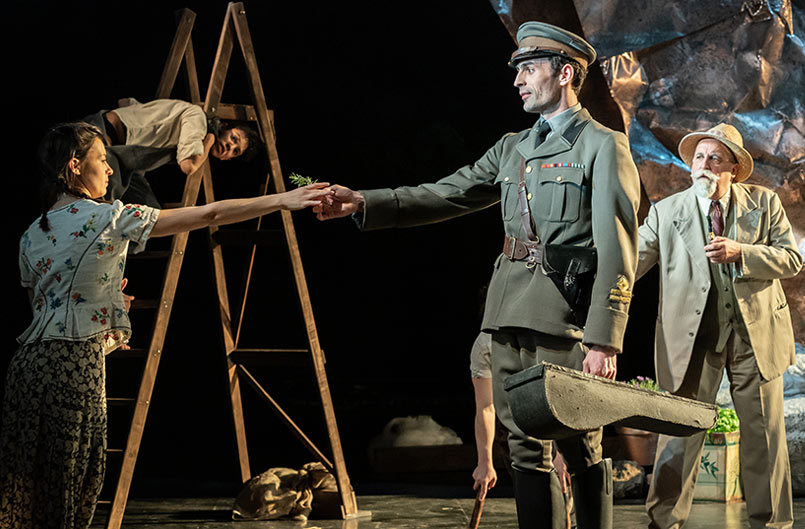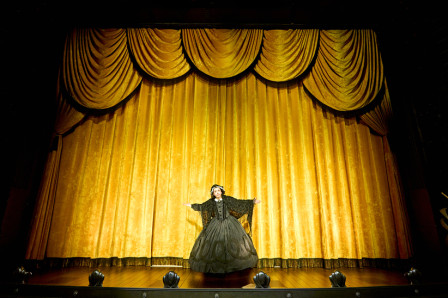Review: CAPTAIN CORELLI’S MANDOLIN at the Harold Pinter Theatre
Until the end of August, the Harold Pinter theatre plays host to a stage adaptation of Louis de Bernières’ multi-award winning, World War II Greek Island romance, CAPTAIN CORELLI’S MANDOLIN and aside from a few minor gripes, it’s a beautifully realised affair.
 Madison Clare, Alex Mugnaioni and Members of the Company in Captain Corelli's Mandolin. Photography by Marc Brenner
Madison Clare, Alex Mugnaioni and Members of the Company in Captain Corelli's Mandolin. Photography by Marc Brenner
The mere mention of the title, induces memories of 1994, when virtually every other person on the tube would be reading a copy of the blue covered paperback. Complete strangers would nod, smile and strike-up conversations by mouthing “It’s really good, isn’t it” - which, in an age where London commuters insulate themselves from humanity by means of their smartphone screens, seems other-worldly now.
Amidst the sedate beauty and teaming wildlife of Cephalonia, a relationship develops between Pelagia (Madison Clare) the proud daughter of the island’s doctor, and a flirtatious local fisherman, Mandras (Ashley Gayle). When Italy declares war, he goes off to fight, whilst she learns medicine from her father and writes countless, unanswered letters to the front - unaware of her man’s illiteracy.
The first-half history lesson plods along charmingly enough, but it is the arrival of the music-loving, reticent Italian ‘invader’ (Captain Antonio Corelli of the title) just before the interval, which energises and elevates the whole.
Believing Mandras to be dead, as time passes, Pelagia gradually falls for the gentle and generous nature of the mandolin playing Captain, (Alex Mugnaioni) who has been assigned her home as a barracks residence, as befits his rank in the occupied territory.
This wonderful stage incarnation of the story, benefits greatly from some astutely realised human animals - notably a goat and pine marten (Luisa Guerreiro and Elizabeth Mary Williams respectively) and an extremely tightly drilled ensemble whose stagecraft is so evident, that George Siena’s choreographed movements take on an almost dance-like quality.
Mayou Trikerioti’s simple set benefits most from the clever use of giant, crumpled, metal sheets which provide a projection backdrop on which appear Dom Baker’s stylised earthquakes, geographic outlines, blood, explosions, tanks, parachutes and many other manifestations of war.
Whilst it would be easy to concede that the running time is perhaps 20 minutes longer than ideal for the average attention span, given the scope of the novel, it is surprising that Rona Munro’s adaptation isn’t a lot longer. Melly Still’s astute and assured direction, has resulted in a captivating evenings entertainment and most importantly, one which is a credit to the source material.
Latest News

 Cast announced for Deep Azure at Shakespeare's Globe
12 December 2025 at 14:32
Cast announced for Deep Azure at Shakespeare's Globe
12 December 2025 at 14:32

 Production images released for Oh, Mary! West End premiere
12 December 2025 at 14:00
Production images released for Oh, Mary! West End premiere
12 December 2025 at 14:00

 Into the Woods at Bridge Theatre Review
12 December 2025 at 13:57
Into the Woods at Bridge Theatre Review
12 December 2025 at 13:57

 Review Round-Up: INTO THE WOODS at the Bridge Theatre
12 December 2025 at 13:05
Review Round-Up: INTO THE WOODS at the Bridge Theatre
12 December 2025 at 13:05